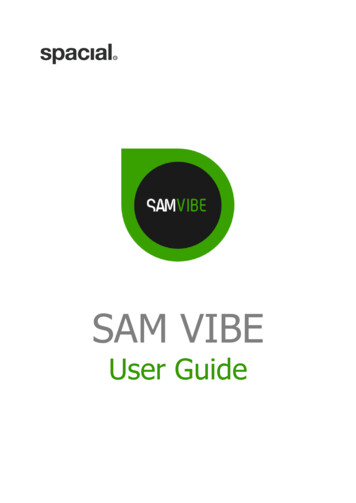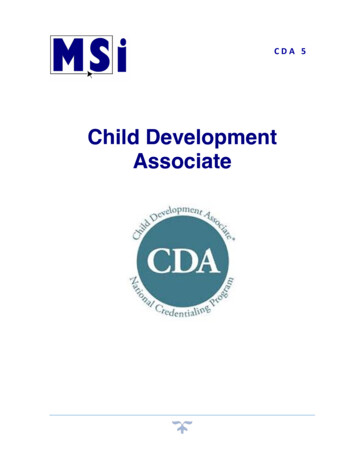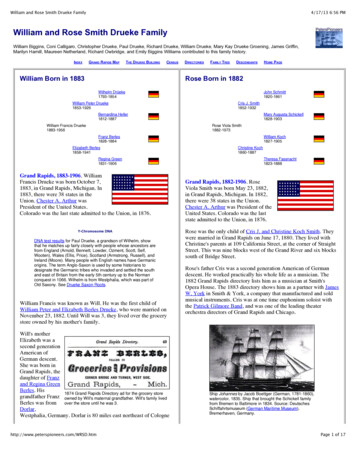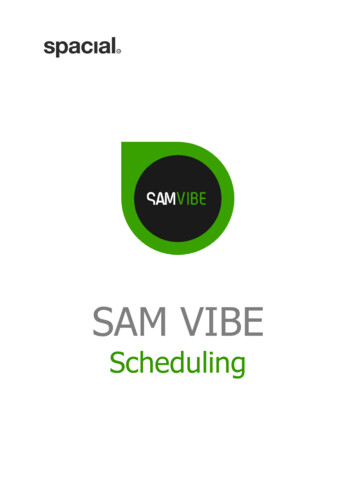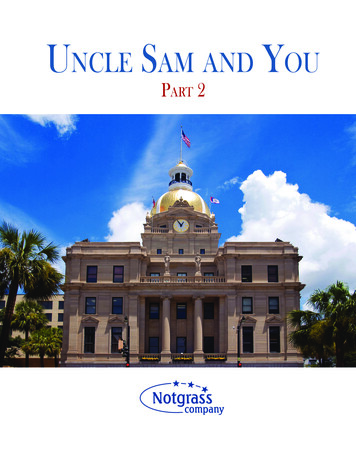
Transcription
Uncle Sam and YouPart 2Notgrasscompany
Previous Page: City Hall in Savannah, GeorgiaUncle Sam and You Part 2by Ray and Charlene Notgrasswith Mary Evelyn McCurdy and Bethany PooreISBN 978-1-60999-047-3Copyright 2012 Notgrass Company. All rights reserved.No part of this material may be reproduced without permission from the publisher.All product names, brands, and other trademarks mentioned or picturedin this book are used for educational purposes only.No association with or endorsement by the owners of the trademarks is intended.Each trademark remains the property of its respective owner.Unless otherwise noted, scripture quotations taken from theNew American Standard Bible, Copyright 1960, 1962, 1963, 1971, 1972, 1973,1975, 1977, 1995by the Lockman Foundation Used by permission.Cover design by Mary Evelyn McCurdyInterior design by Charlene Notgrasswith Mary Evelyn McCurdyPrinted in the United States of AmericaNotgrass Company975 Roaring River RoadGainesboro, TN com
UNIT 25 — TECHNOLOGY & COMMUNICATIONLESSONS IN UNIT 25Lesson 121 — American TechnologyLesson 122 — From Tin Cans to Smart PhonesLesson 123 — The Travels of a Piece of MailLesson 124 — Voice of AmericaLesson 125 — Choose an American HolidayBOOKS USED IN UNIT 25 The Citizen’s Handbook The Wright Brothers: How TheyInvented the Airplane Student Workbook (optional) Lesson Review (optional)New York Public Library, New York City
AmericanTECHNOLOGYLESSON 121America is a world leader in science and technology. Science is the study of how andwhy things happen. Technology uses the knowledge learned in science to make thingshappen. Americans like to make things happen.On this page and the next is a timeline of many American inventions. Because Americais free, inventors can turn those inventions into businesses that manufacture and sell tothousands or millions of people. Scottish immigrant Alexander Graham Bell did just that withthe telephone, as did Orville and Wilbur Wright with the airplane, Bill Gates with computersoftware, and the list goes on.Timeline of American Inventors and TechnologyPhiladelphia, PennsylvaniaFairmount Water WorksHarrisburg, PennsylvaniaTelegraph Device in State Capitol7541752 – Among Benjamin Franklin’s many inventions was the lightningrod.1776 – David Bushnell of Connecticut invented the first practicalsubmarine, calling it the Turtle.1794 – Eli Whitney of Connecticut patented a cotton gin, which madeproducing cotton much faster.1801 – The Fairmount Water Works began using steam power to providePhiladelphia city water.1807 – Robert Fulton’s steamboat the Clermont traveled from New Yorkto Albany at five miles per hour.1814 – John Jethro Woods of Poplar Ridge, New York, created a castiron plow tip that improved farming.1831 – Cyrus McCormick invented the McCormick reaper. By 1871 hiscompany sold 10,000 per year.1836 – Samuel Colt developed the Colt revolver when he was twenty-two.1844 – Samuel F. B. Morse demonstrated the telegraph in the U.S.Capitol with the words, “What hath God wrought.” Histelegraph method made it possible to communicate quickly overlong distances.1850 – Isaac Singer improved Elias Howe’s sewing machine. By 1880yearly worldwide sales reached 500,000.1853 – Elisha Otis of Vermont demonstrated his safety elevator at theCrystal Palace Exposition in New York.1859 – Edwin Drake struck oil by drilling 69.5 feet into the ground atTitusville, Pennsylvania, beginning an oil boom.
1863 – James Plimpton of Massachusetts invented the firstpractical roller skates with four wheels.1876 – Alexander Graham Bell made the first telephone callto his assistant Thomas Watson. Two years later atelephone was installed in the White House. In 1882the Scottish-born inventor became a U.S. citizen.1877 – Thomas Edison invented a machine that recorded thehuman voice.1879 – Thomas Edison perfected the incandescent light bulb.1891 – Thomas Edison and William Dickson perfected anearly type of movie projector called a kinetoscope.1893 – Whitcomb L. Judston introduced his clasp-locker atthe World’s Columbian Exposition in Chicago. It wasFort Myers, Floridalater renamed the zipper.Thomas Edison’s Laboratory1902 – Willis H. Carrier invented air conditioning. He laterat His Summer Homebegan the Carrier Corporation.1903 – Orville and Wilbur Wright fly the “Flyer I” at Kitty Hawk, North Carolina.1908 – Henry Ford introduced the Model T automobile.1920 – The first regular radio broadcast began at KDKA in Pittsburgh, Pennsylvania, when the stationannounced the results of the 1920 presidential election.1927 – Philo Farnsworth demonstrated the first television. The first television image was a dollar sign.1937 – Engineers from the Union Pacific Railroad built the first ski lift. It was used at Sun Valley, Idaho.1948 – Leo Fender began to sell electric guitars.1951 – The U.S. Census Bureau purchased the first commercial computer, called the UNIVAC 1, from the Eckertand Mauchly Computer Co. of Philadelphia.1960 – Theodore H. Maiman created the first laser.1962 – On July 23, the Telstar satellite, invented by AT&T and launched by the National Aeronautics and SpaceAdministration (NASA), beamed the first live video images from America to Europe and from Europe toAmerica.1965 – The Digital Equipment Company introduced the first computer with integrated circuit technology.1969 – American astronaut Neil Armstrong became the first human to walk on themoon.1970 – Corning Glass created an effective optical fiber which used light to sendinformation.1973 – Dr. Martin Cooper and his team at Motorola invented the first portablemobile phone.1974 – American stores began to use barcodes. Checkout stands use laser technologyto read them.1975 – High school friends Bill Gates and Paul Allen formed Microsoft, whichproduces computer software.1976 – Steve Jobs, Steve Wozniak, and Ronald Wayne began to sell Apple computerkits.1977 – Two thousand customers in Chicago began testing cell phones. Thesephones came to be called cell phones because geographic areas are dividedinto “cells.” Each cell has its own cell phone tower. A cell phone works bytransmitting radio waves to the nearest tower.1981 – NASA launched and landed the first Space Shuttle.1983 – Each year Time Magazine names someone the “man of the year.” In 1983 themagazine named the personal computer “machine of the year” instead.1996 – Stanford University grad students Larry Page and Sergey Brin beganThe State of Utahworking on an Internet search engine. The following year they named itdonatedthis statue ofGoogle.Philo Farnsworth to U.S.2001 – Apple Inc. released the iPod.Capitol’s Statuary Hall.2007 – Apple Inc. released the iPhone.755
Created in the Image of GodThe Christian worldview encourages the development of technology. Christianityrecognizes that God created human beings in His image (Genesis 1:26). God created peoplewith minds that can think, investigate, research, learn, and compile information. We havetechnology because we have minds. You will not see or hear about rat technology or mosquitotechnology because those creatures do not have the minds necessary to develop it. Christiansbelieve that God commanded humans to “fill the earth, and subdue it” (Genesis 1:28). Obeyingthis command involves a belief that the world makes sense, that we can understand it, andthat we can use it. We must be good stewards of the physical world that God placed in ourcare. We can use it to live well and to bless others. Christianity honors work (Colossians 3:23).Christians are willing to work to honor God, to provide for ourselves, and to help others. Webelieve that what we do can make a difference in the world, so we work for that purpose.Free to Work and CreateThe freedom that we enjoy in America enables people to pursue their interests with energyand enthusiasm. If someone has an idea for an invention or a business, he or she can work tofulfill that dream without the need to get approval from a government official. The United Stateshas always valued education. A good education trains the minds that produce technologicaladvances.Our country has abundant natural resources and a large workforce, but these alone do notguarantee the development of technology. Americans have always believed that it is importantto be productive. Productivity involves to what degree workers are able to use abilities andresources to produce goods and services.Because we have freedom of speech, we can communicate freely. When we learn history, welearn what past Americans have communicated about what they did. Having this knowledgehelps us build on what past generations have learned. New technology builds on the technologyproduced in the past.Government and TechnologyGovernment plays a role in encouraging technology. America has benefited from a stablegovernment. Stability helps people develop new ideas and inventions. It is hard to do researchand invent new products when people live in constant fear of war, revolution, governmentcorruption, and economic uncertainty. American government has also provided copyrightand patent protection to people who develop new products. See patent office on page 757.When a book is copyrighted, others can not legally copy it. When an invention is patented,756
others cannot legally make something exactlylike it. A lack of copyrights and patents woulddiscourage people from inventing becausean inventor would not be able to receive theprofit he deserved from manufacturing andselling what he has produced from his owncreativity. The most important way that ourgovernment encourages the developmentof technology is by staying out of the wayof individuals and private businesses andprotecting their freedoms.Technology for AllWashington, D.C.Stored Patents and Patent Office Employees, 1940The way that technology has the greatest impact is when individuals use it to serve thegreatest number of people. A person can make a profit by developing technology to producebetter yachts and limousines for the wealthy. However, more Americans have made moreincome and have helped to raise the standard of living for a greater part of the Americanpublic by developing technology that helps many people. For instance, when the telephoneand the automobile were first invented, they were seen as merely playthings for the wealthy.It was when Americans figured out a way to make these products available at a reasonablecost that millions were helped by them, and American life was improved overall. Jobs werecreated, too, which helped even more people and the American economy as a whole.Communication TechnologyCommunication is sharing ideas and information.Communication technology helps us to share information.It also helps us share ideas faster and with more people.American technology has created or improved many meansof communication (various types of communication are oftencalled media). Samuel F. B. Morse developed a successfultelegraph that transmitted information quickly over longMessage from President Lincoln whichwas telegraphed to General Grantdistances. At right is a message President Lincoln wrote, which was sent by telegraph toGeneral Ulysses S. Grant during the Civil War. It reads: “I have seen your dispatch expressingyour unwillingness to break your hold where you are. Neither am I willing. Hold on with abulldog grip, and chew and chop, as much as possible.”Alexander Graham Bell invented thetelephone, which made it possible to use electricity to send speech. Thomas Edison invented757
the phonograph, which gave people a way torecord and preserve sounds, including voicesand music. Americans developed the firstcommercially successful typewriter, allowingpeople to communicate their ideas faster. Thefirst author to have a manuscript typed wasAmerican Samuel Clemens, known better byhis pen name Mark Twain. Italian GuglielmoMarconi invented the radio; but the radio hadits greatest early success in the United States.Television was successful in the United StatesNorth Pole, AlaskaThe letters of the KJNP FM Radio Stationstand for King Jesus North Pole.first as well.American company AT&T created the first communication satellite that made it possible forpeople to send television video around the world. American computer and Internet technologyhave enabled people to send and receive enormous amounts of information quickly in almostall parts of the globe. Cell phones have helped people to stay in touch and have helped manypeople who were experiencing an emergency.Technology and CivicsTechnology impacts civic life. For example, technology helps Americans learn aboutcandidates and elections. Inventors have used it to create voting machines. Technology allowsAmericans to file their income tax returns electronically. Technology allows first respondersto help citizens faster. Television technologymakes possible C-SPAN, the cable and satellitetelevision service that broadcasts meetingsof Congress. Through C-SPAN almost everyAmerican can see more of what actuallygoes on in Washington. Commercial radioand television stations also use technologyto keep Americans informed about theirgovernment. See photo at right. The Internetallows information about city, county, andstate governments to be widely available so758Washington, D.C.Television cameras are ready to film newsat the U.S. Supreme Court.
that we know what services are offered and what office weshould contact if we have a particular need.Technology and the ChristianTechnology, especially communication technology, putspeople in contact with new ideas. Some of those ideas are goodand some are evil. Wise Christians are diligent to protect theirown hearts and minds and those of their children by beingcareful what technology brings into their lives and minds.Technology has given Christians the opportunity to sharethe good news of Jesus with more and more people aroundthe world. Christians have produced television programs,St. Thomas, U.S. Virgin IslandsUsing a Library Computerradio programs, and websites that teach about Jesus. Christianmissionaries do not have to feel as lonely and isolated as theyonce did because they can keep up with their loved ones with cell phones and video chattingover the Internet. . . faith comes from hearing, and hearing by the word of Christ.Romans 10:17Lesson ActivitiesThinking Biblically — In your notebook, make a list of ten ways people have used technologyto share the message of the gospel.Literature — Read “Aim for the Stars” in The Citizen’s Handbook pages 145-147.Find Out! — Ask your parents when they got their first computer.Picture This! — Take a photograph or draw a picture of three kinds of technology your familyuses regularly.Student Workbook or Lesson Review — If you are using one of these optional books, completethe assignment for Lesson 121.759
From Tin Cans toSMART PHONESLESSON 122God created people with the ability to communicate. Wehave eyes to see and ears to hear, the ability to speakand write, and a mind that can process information andconsider ideas. We can communicate with each other throughspeech, written words and symbols, a touch of the hand, anexpression on one’s face, and what we call body language.The importance of communication is shown by the fact that,Duluth, MinnesotaLighthouse on Lake Superiorwhen God wanted to communicate His love for us, He sentHis message in the form of His Son, whom John 1:1 calls theWord.Communication is essential in civics. Monuments andmemorials communicate respect for the people and events ofthe past. Signs communicate laws and instructions that helpour civic life run smoothly. First responders turn on sirensto communicate that drivers should move their vehicles outof the way. Lighthouses, like the one pictured at left above,flash lights and sound horns to signal information to ships.Political candidates communicate their beliefs and goals tovoters. Government officials make public announcements inboth print and online editions of newspapers.The story of the invention and development of thetelephone is an example of technology. This story weavestogether our desire to communicate, the use of technology,Harrisburg, PennsylvaniaOffice for Newspaper Reporters and aSlot in an Office Door for NewspaperDeliveries at the State Capitol760and the impact of communication technology on our personallives and on our civic life.
The Waves That God MadeWhat is a telephone? Perhaps the simplest kind is just two tin cans or paper cups and apiece of string. This telephone works because sound travels in waves. This is how it works: Bob and Jane’s parents punch a hole in the bottoms of two tin cans. The childrenconnect the cans by placing a long piece of string through the holes. Each child takes one can and they walk several feet away from one another. Jane puts her can to her mouth while Bob puts his can to his ear. When Jane speaks, the sound vibrates her can, which vibrates the string, whichvibrates Bob’s can. Bob hears Jane’s voice.God created many kinds of waves. Light rays, radio waves, X-rays, and other rays are partof the electromagnetic spectrum. God also created sound waves, which are not a part of thespectrum. Inventors have used both sound waves and waves of the electromagnetic spectrumto create telephones.On and Off“Yes” or “no” is the simplest form of communication. The simplest form of electroniccommunication is also yes or no. An electrical circuit is either complete or incomplete, on oroff, connected or disconnected. This binary (two-way) system is a simple form of technology.It is how electronic communication began, and it is still used today.When Samuel F. B. Morse perfected the electromagnetic telegraph in 1838, it used the onor-off pattern of electrical impulses to send signals across a wire. Morse developed a code ofsignals for the alphabet that enabled messages to be sent by telegraph wires over long distances.From the Telegraph to AT&TA generation later, Alexander Graham Bell was a teacher of people who were deaf. Hefollowed in the footsteps of his father and grandfather who had developed a system of symbolsthat gave deaf persons a way to communicate with others. Bell experimented with sound andspeech and became interested in transmitting speech with electricity in a way similar to thesignals sent by a telegraph. Telegraphs could only send one message at a time. Bell thoughtthat different signals could be sent at the same time, just as people hear different notes at thesame time when they listen to music. While researching ways to do this, he learned how tosend the sound of a human voice through a wire. When Bell spoke through an experimentaldevice to his assistant Thomas Watson on March 10, 1876, the telephone was born.761
Alexander Graham Bell received a U.S.patent for his invention that year. Bellwas able to communicate the news of hisinvention to people from many countrieswhen he demonstrated it at the CentennialExposition in Philadelphia later that year. In1877 he formed the Bell Telephone Companywith Thomas Watson serving as its manager.Pictured at right are some of Bell’s firstinventions, which he personally donatedto the Smithsonian Institution. By the endof 1880, over 47,000 telephones were in use.Alexander Graham Bell’s daughters and great-grandson,also named Alexander Graham Bell, along with scientists,examine Bell’s donations to the Smithsonian, 1937.Word got around! Bell’s original companyeventually became the American Telephone& Telegraph Company (AT&T).2Operators and Exchanges1For almost one hundred years, AT&Tleased telephones to their customers. At first,they were leased to customers in pairs. ARotary Dial DeskTelephone, 1920sbusinessman, for instance, might have onetelephone in his office and another in hishome. Calls could only be made betweenDesk Telephone,c. 19053those two telephones.In 1878 the first public telephone exchange was establishedin New Haven, Connecticut. A customer would signal hisdesire to place a call by picking up his ear piece. See phones1 and 3 at right. An operator at the exchange would respondand connect the caller to the telephone he wanted to reach.Wall Telephone, 1920sThe exchange could handle sixty-four customers; but onlytwo conversations could take place at the same time.Almon Strowger, an undertaker in Kansas City, Missouri,invented an automatic switchboard in 1889. The telephones inthis system had a button on them that the caller could pushto produce a series of pulses that signaled what telephone hewanted to reach. A system of switches (again using the on7624Princess Telephonewith Rotary Dial, c. 1961
and-off principle) connected the caller to thattelephone.As telephone use began to spread acrossthe country, AT&T set up telephone polesalong the nation’s highways and streets andstrung telephone wire on them. AT&T hiredtelephone operators to operate switchboards.right.Miss Harriot Daley, Chief Switchboard Operatorfor the U.S. Capitol standing with other operatorsin 1937. Miss Daley was appointed in 1898.Rotary Dials and Touch ToneIn 1896 Almon Strowger and his associates developed a5Color Photos on Pages 762-763 by Mark MathosianSee U.S. Capitol switchboard operators attelephone with a rotary dial. See photos 2 and 4. Customerscould turn the circular dial to a series of numbers to reach atelephone that had been assigned that “telephone number.”After the invention of the rotary dial telephone, the humantelephone operator was only needed to connect calls toother exchanges (these calls were called long-distance calls)and to look up telephone numbers when a telephone user6did not know the telephone number of someone he wishedto call. Telephone systems also began to use a dial tone thatcustomers heard when they picked up the receiver. This tonelet customers know that they could place a call.Photos 5 and 6 illustrate phone numbers, the dial tone, andan exchange, in this case, the “Windsor” exchange. Notice thatW and I are capitalized. The numbers 2 through 9 on a phoneThese phone cards could be placedin the center of the rotary dial. Thelower card is an advertisement forthe Triangle Cab Co. Notice theemergency numbers.dial had letters printed above them. When someone called thephone number in illustration 5, they dialed W which stood for9, I which stood for 4, and then the numbers 0-2577.Bell Labs, the research division of the Bell TelephoneSystem, developed a touch-tone system of placing calls in1941. This telephone used push buttons that sent tones to anautomatic switching system which connected the call. Touch-7tone service was offered to the public beginning in 1963 foran extra fee, but most people continued to use rotary dialtelephones until the 1980s. Phone number 7 is a 1993 version.Touch Tone Princess Phone, 1993763
Cordless Phones and Cell PhonesScientists developed radio technology during the twentiethcentury, and radio and telephone technology sometimesmerged. During the 1930s, a person on land could makea radio-telephone call to a ship at sea for seven dollars perminute. In the 1960s, cordless telephones were developed thatused radio signals sent between a handset and a telephonebase, which was connected to the wired telephone system.These became available to the public in the ies began to transmit sound digitally. Sounds couldbe converted to digital signals, which were basically on-or-offelectronic pulses that could be sent or stored. This allowed forgreatly improved cordless telephone sound quality, but it alsocreated the possibility of another kind of telephone signal.The first mobile phones were used in cars, especiallypolice cars. In 1947 Bell Lab scientists proposed a system ofphones capable of broadcasting digital signals to towers thatwould each cover a certain area called a cell. The towers couldCommunications antennae havebeen placed on a silo in Burlington,Vermont, a fire tower in Moriah,New York, a water tower in SouthBurlington, Vermont, and a churchsteeple in Bloomsburg, Pennsylvania.transmit signals to other towers, so that the call could go asfar as the tower network extended. A plan for such a systemwas developed in the 1970s. Motorola developed the firsthandheld mobile phone in 1973. It weighed 2 1/2 pounds, wasnine inches long, and could be used for thirty minutes aftercharging for ten hours. Continued development of cell phone technology resulted in muchsmaller and much more powerful phones.Phones, Data, and the InternetThe fact that voice signals could be converted to digital form meant that other kinds of datacould be transmitted in digital form also. Alexander Graham Bell’s invention was designed tocarry the sound of the human voice, but today people also use their phones for sending writteninformation. One way is by text messaging. The first person-to-person text message was sentin 1993.The network of computer networks called the Internet uses telephone lines, fiber opticcables, and satellites to send digital information signals between computers around the world.764
The line between telephone companies and Internet provider companies has blurred. Nowtelephone companies offer Internet service, Internet providers offer telephone service, andVoice over Internet Protocol (VoIP) phones use the Internet for making calls.International Business Machines (IBM) invented a personal communicator called Simonin 1992. It was a combination cell phone, pager, fax machine, calculator, calendar, clock, andcomputer. Since it cost 899, few people could buy it. However, companies continued to workon smart phone technology that would be affordable. In 2007 the Apple computer companyintroduced the iPhone. In addition to making calls, the iPhone allowed users to access theInternet for e-mail, web browsing, and other applications. Today the iPhone and othersmartphones are often used as much for receiving data from the Internet as for receiving calls.The Break-Up of AT&TThough a few businessmen formed small telephonecompanies, especially in rural areas, AT&T had very littlecompetition during its first century. Late in the twentiethcentury, the Federal Communications Commission (FCC)and Federal courts forced AT&T to break apart into smallerregional companies.Chesapeake and Potomac TelephoneCompany “Telephone Girls,” 1914Telephones and CivicsTelephones play an important role in the civic life of acommunity. We expect government workers on the local,state, and national levels to have telephones in their offices;and citizens expect to be able to contact them by phone. Aquick way to get an answer or to register a complaint is to callthe government office responsible for the matter. Sometimesthe offices of elected representatives get flooded with callsabout a piece of proposed legislation, and these calls canmake a difference. A quick round of calls can turn out a largegroup at a city council meeting. Some political candidatespay for automated calls shortly before Election Day thatNashville, TennesseeAT&T Building with RymanAuditorium Roofplay a recorded message urging voters to support them. Many people debate whether these“robocalls” are effective or simply annoying. The placement of cell towers in a way that doesnot detract from area scenery or interfere with community life is a continuing issue. Somechurches have agreed to let cell towers be placed in their steeples or bell towers.765
The most famous government telephone was the “hotline” that was installed betweenthe White House and the Kremlin, the headquarters of the Russian government in Moscow,during the Cold War period of tension between the U.S. and the Communist Soviet Union.In 1962 the two governments had a tense showdown over Soviet missiles being put in Cuba.Communication between Washington and Moscow was difficult and slow. The next year, thetwo governments established a special line that made communication quicker in the event ofan emergency. The first hotline was actually not a telephone but was a teletype machine. Themachine sent typed messages that could be translated for the receiving officials. The hotlinewas often portrayed as a red telephone in the President’s Oval Office. A telephone line using ared phone was installed in 1971. The President and the Soviet leader did contact each other afew times on the hotline, often about events in the Middle East. Satellite communication lineswere added in later years.President Dwight Eisenhower was an intelligent person and an able leader, but during hismilitary career and as President he did not have to place telephone calls himself. Whenever hewanted to call someone, he simply picked up a phone and a switchboard operator completedthe call for him. When Eisenhower retired from the presidency in 1961 and moved to his homein Gettysburg, Pennsylvania, he did not know how to use a rotary phone and didn’t knowwhat a dial tone was. A Secret Service agent instructed the former President and five-stargeneral on how to use the device. Eisenhower spent the next hour happily calling friends andexperiencing the delight of making telephone calls.Telephone EtiquetteThe development and use of telephones created new rules of polite society. One early issueinvolved what to say when you answered a call. Alexander Graham Bell suggested that aperson receiving a call say, “Ahoy!” as a ship would say to another approaching ship. ThomasEdison, who also developed telephone technology, suggested the more simple “Hello?” Formany years wealthy people and people in positions of power did not make or answer callsthemselves. These were jobs for servants or office staff to do. The master or executive got onthe phone only after the connection was established.In the days when telephones were relatively rare and not used often, local phone systemsoffered party lines to subscribers. The advantage was that the cost to be on a party line wasless than having a private line. A party line allowed up to eight homes to use the same line,and
Communication is sharing ideas and information. Communication technology helps us to share information. It also helps us share ideas faster and with more people. American technology has created or improved many means of communication (various types of communication are often called media). Samuel F. B. Morse developed a successful
